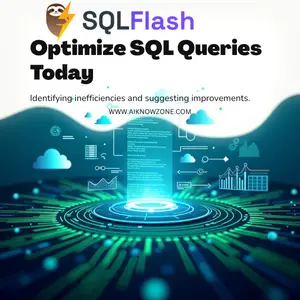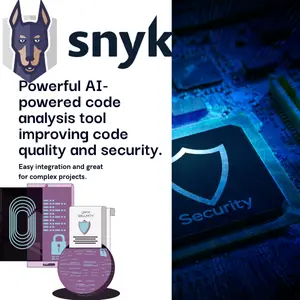SQLFlash
Discover how SQLFlash revolutionizes SQL optimization with AI-powered precision, providing clear insights for developers.
Description
SQLFlash Review: Is This AI SQL Optimizer Worth It? 🤔
Let’s face it, SQL optimization can be a real headache. Spending hours tweaking queries, wrestling with execution plans, and feeling like you’re constantly firefighting slow database performance? Yeah, been there. That’s where SQLFlash comes in. This AI-powered tool promises to revolutionize how developers optimize SQL, offering a blend of advanced technology and engineer-friendly insights. Basically, SQLFlash aims to take the pain out of SQL optimization by using AI to automatically identify bottlenecks and suggest improvements. No more late nights debugging or relying solely on DBAs! The main goal of SQLFlash is to streamline the optimization process, enabling developers to focus on building core business logic rather than getting bogged down in the intricacies of SQL tuning. It’s designed to be accessible even for developers who aren’t SQL experts, bridging the expertise gap and empowering teams to achieve faster and more efficient database performance. So, is it as good as it sounds? Let’s dive in and find out!
Key Features and Benefits of SQLFlash 🌟
- AI-Powered Query Optimization: SQLFlash uses sophisticated AI algorithms to analyze and rewrite slow SQL queries, resulting in significant performance improvements. This means faster response times and a better user experience.
- Actionable Index Recommendations: The tool doesn’t just identify problems; it provides specific recommendations for creating or modifying indexes to optimize query performance. These suggestions are tailored to your specific database schema and workload.
- Automated Bottleneck Detection: SQLFlash automatically identifies performance bottlenecks in your SQL code, saving you the time and effort of manual analysis. The AI pinpoints the exact areas that need improvement, allowing you to focus your optimization efforts where they matter most.
- Engineer-Friendly Insights: The tool provides clear, understandable explanations of its optimization recommendations, so you can understand why the changes are being suggested and learn how to improve your SQL skills. This transparency helps build trust in the AI and empowers developers to make informed decisions.
How SQLFlash Works (Simplified) 🛠️
Using SQLFlash is pretty straightforward. The process generally involves connecting SQLFlash to your database, submitting your SQL queries to the tool, and then letting the AI work its magic. Once connected, you provide your SQL statement. The tool then analyzes the statement, identifying potential performance bottlenecks and areas for improvement. Next, SQLFlash suggests optimized versions of your SQL query, along with explanations of the changes. After reviewing the suggested improvements, you can apply them directly to your database or further refine them based on your specific needs. The entire process is designed to be quick and easy, even for developers who are not SQL experts. You copy and paste your SQL code and let the AI engine do the work. The AI engine will offer the improved code.
Real-World Use Cases for SQLFlash 💼
- E-commerce Platform: Imagine you’re running an e-commerce platform, and your product search queries are getting slower and slower as your product catalog grows. I used SQLFlash to analyze these queries and it identified several missing indexes that were causing full table scans. After implementing the recommended indexes, the search queries became noticeably faster, improving the user experience and boosting sales.
- Financial Institution: A financial institution was struggling with slow SQL queries that were impacting their ability to generate timely and accurate financial reports. SQLFlash helped them optimize complex nested subqueries, reducing the report generation time from hours to minutes. This allowed the bank to make faster and more informed decisions.
- Online Learning Platform: An online learning platform was experiencing performance issues with course progress queries, especially during peak hours. SQLFlash identified inefficient joins and implicit conversions in the SQL code. By optimizing these areas, the platform was able to ensure real-time updates for students and teachers, improving the overall learning experience.
Pros of SQLFlash 👍
- Significant performance improvements in SQL queries.
- Easy to use, even for non-SQL experts.
- Provides clear explanations of optimization recommendations.
- Automated bottleneck detection saves time and effort.
Cons of using SQLFlash 👎
- May require some initial setup and configuration.
- The AI’s recommendations may not always be perfect and require some manual adjustments.
- Reliance on OpenAI’s o1-preview model (potential dependency).
SQLFlash Pricing 💰
Unfortunately, specific pricing details weren’t readily available in the provided search snippets. You’ll need to visit the SQLFlash website (sqlflash.ai) to get the most up-to-date pricing information, which may include different tiers based on usage or features.
Conclusion 🏁
In conclusion, SQLFlash appears to be a promising tool for developers looking to optimize SQL performance without needing to be SQL gurus. Its AI-powered approach, coupled with engineer-friendly insights, makes it a valuable asset for any team dealing with database performance issues. If you’re tired of wrestling with slow queries and want to leverage the power of AI to streamline your SQL optimization process, SQLFlash is definitely worth checking out. I’d recommend it to developers of all skill levels who want to save time, improve database performance, and focus on building great applications. Just remember to check the latest pricing details on their website before making a decision! The tool definitely helps boost SQL performance with expert-trained AI optimization, which is what most companies want!






Reviews
There are no reviews yet.